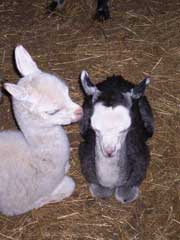[fusion_builder_container hundred_percent=”yes” overflow=”visible”][fusion_builder_row][fusion_builder_column type=”1_1″ background_position=”left top” background_color=”” border_size=”” border_color=”” border_style=”solid” spacing=”yes” background_image=”” background_repeat=”no-repeat” padding=”” margin_top=”0px” margin_bottom=”0px” class=”” id=”” animation_type=”” animation_speed=”0.3″ animation_direction=”left” hide_on_mobile=”no” center_content=”no” min_height=”none”][fusion_imageframe lightbox=”no” lightbox_image=”” style_type=”bottomshadow” hover_type=”none” bordercolor=”” bordersize=”0px” borderradius=”0″ stylecolor=”” align=”right” link=”” linktarget=”_self” animation_type=”0″ animation_direction=”down” animation_speed=”0.1″ hide_on_mobile=”no” class=”” id=””]  [/fusion_imageframe][fusion_text]
[/fusion_imageframe][fusion_text]
Alpacas
Who raises alpacas?
Alpaca owners and breeders come from all walks of life. Many are doctors, financial advisors, educators, or cattle farmers, to name a few. Some raise alpacas as a full-time business, others commit part-time. From young families to empty-nesters, phased retirement to full-retirement, raising alpacas offers countless options for everyone.
Why do people raise alpacas?
Alpacas offer a very attractive business and farming opportunity no matter where you live: urban, suburban, or rural. Urban dwellers can board (or “agist”) their alpacas at nearby farms/ranches so that they can enjoy the benefits of ownership while living in a large city or suburb. People also raise alpacas for companionship and to enjoy a rural lifestyle.
How do you transport an alpaca?
If traveling for short distances, they can be transported inside vans or other larger vehicles. Most folks put down a piece of old carpeting or inexpensive Astro-turf to minimize the impact on the vehicle’s carpeting in case an “accident” were to occur. Most of the time, however, the animals will “cush” (that is, sit down) for the journey. Longer distances generally require transport in a livestock trailer.
How much acreage does it take to raise an alpaca?
Because the animals require so little pasture and food, you can usually raise five to ten alpacas per acre, depending on terrain, rain/snowfall amounts, availability of pasture, etc. They can also be raised on dry lot and be fed grass hay, if desired. Consult with your local County Extension Officer for specific local recommendations.
Are alpacas easy to care for?
They are a small and relatively easy livestock to maintain. They stand about 36 inches tall that the withers (the point where the neck and spine come together), weigh between 150-200 pounds, and establish communal dung piles that are easy to manage. The alpacas need basic shelter and protection from heat and foul weather, and being livestock, they do require certain vaccinations and anti-parasitic medicines. Additionally, their toenails need to be trimmed every couple of months and the fleeces sheared off once a year. Speaking of toenails, these animals do not have hooves-they have two toes, with hard toenails on the top of their feet and a soft pad on the bottom of their feet, much like a dog’s foot. Therefore, you don’t experience compaction of the soil to same degree that you would with other types of livestock.
Can you raise alpacas in a hot, humid climate?
The answer is generally yes. Alpacas have proven to be amazingly resilient animals. Alpacas are being raised successfully in Arizona, Texas, Louisiana, Mississippi, Florida and also in Alaska and many Canadian provinces. Certainly, in the hotter, more humid climates, the alpaca breeder does need to take health and safety precautions, like shearing fleeces off early in the year, providing plenty of fresh water to drink and dip their bellies into, and areas of shade.
What type of shelter and fencing do alpacas need?
This varies widely, depending on such things as weather and predators. But as a general rule, the alpacas do need at least a three-sided, open shelter where they can escape inclement weather. And if predators are present in your neighborhood, then a minimum of five-foot-high, 2″ by 4″ no-climb fencing is necessary to keep out the predators. Traditional horse fencing (with 4″ by 4″ openings) is not recommended, as curious alpacas might be physically harmed if they put their heads through that type of fencing.
What do alpacas eat?
The main thing alpacas eat is just grass or hay, and not much of it-approximately two pounds per 125 pounds of body weight per day. A single, 60-pound bale of hay can generally feed a group of about 20 alpacas for one day. Alfalfa is discouraged or red only sparingly, as it has high protein content that can be unhealthy for the animals. Additionally, all alpacas require access to free-choice mineral supplements and plenty of fresh water to drink.[/fusion_text][/fusion_builder_column][/fusion_builder_row][/fusion_builder_container]

